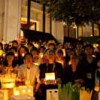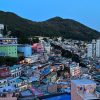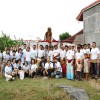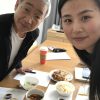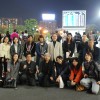Date of Issue:September 04, 2019
・Activity 1/City Night Survey Chongqing City (2019/07/04-07/05)
・Activity 2/City Night Walk Vol.64 : Skybus Tour(2019/07/26)
・Activity 3/Congraturation on Newsletter Vol.100
City Night Survey Chongqing City
2019.07.04 – 2019.07.05 Nasahiro Iwata+Clement Lee
We spent two days investigating Chongqing City in China on July 4th and 5th. We investigated life in the city, its culture, and history (that links back to the Song dynasty) and how those are changing and coexisting with the new developments there, focusing on the evolution of lighting and how that affects the people and the building development there.
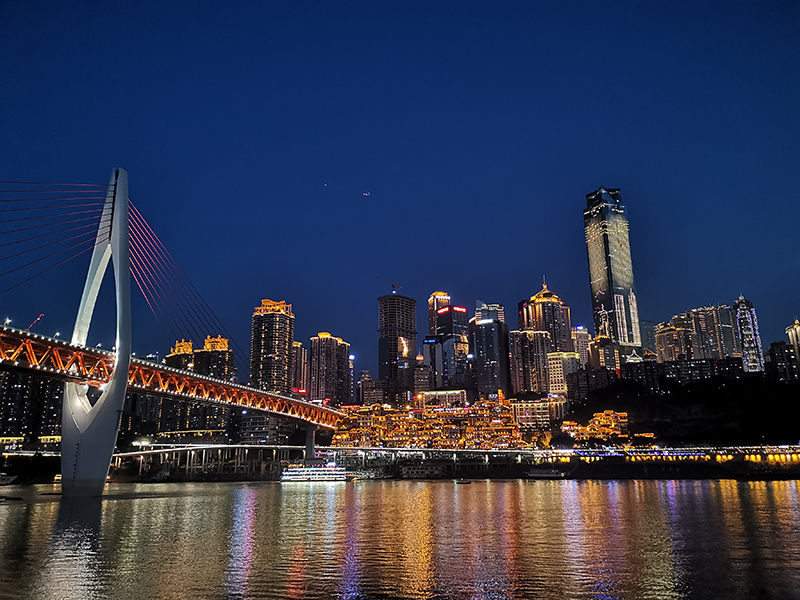
Chongqing’s Central Area
Chongqing is famous for its spicy hot pot. For my first visit, I set off anticipating findings that were more thrilling than the spicy peppers in their local cuisine.
The lives of those in Chongqing
Our investigation is based in Chongqing Yuzhong District. Here it is around 6 km east to west and 2km north to south and was developed as an extremely compact city, surrounded by both the Jialing and Yangtze rivers, and is almost an island. It is supported by a man-made base made using the method of Jiajiaolou and floats as if it’s a mountain above the sea. Sometimes to go to the other side of the building, you have to take an elevator from underground to the 11th floor or take a detour. Chongqing is a city that is also known by the name of ‘Mountain Castle’ and because of the 3-dimensional mixing that occurs in this city, the residents’ movements are also connected through their verticality, and it is interesting to see the many unique layers where people interact. During our investigation, we were not blessed by the weather and the area was brownish even during the daytime giving us a dark atmosphere. The bus also was dark without lights on during the daytime. There were also quite a few restaurants with a single LED lightbulb as their light source, or many working outside as it was brighter than indoors; it seemed that most residents have accepted this darker lighting environment.
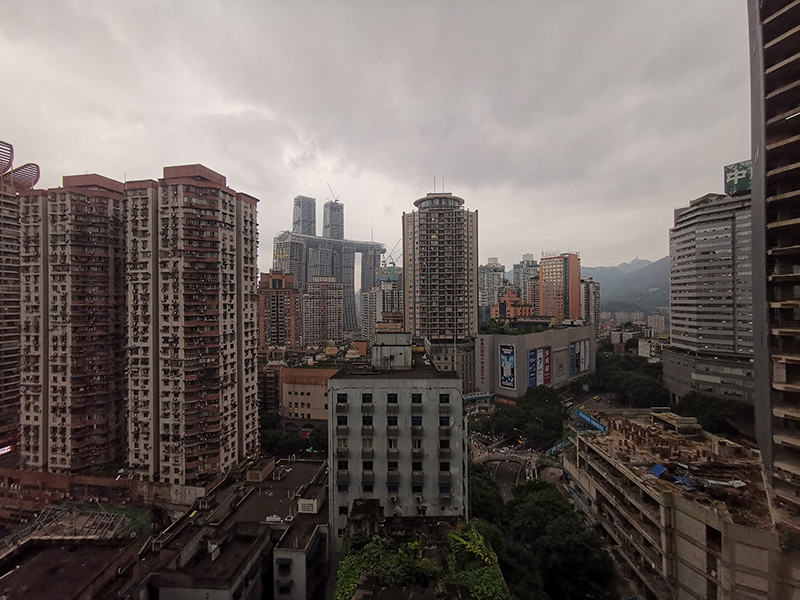
The Brownish view in the daytime

The bus lights are turned off in the daytime

There were also restaurants lit with a single LED bulb
The Lightshow as viewed from Hong Ya Dong
There is a famous tourist location in Chongqing City called HongYaDong. It is a collection of stores and built into a cliff and in layers as I mentioned before. The architecture is lit up in a warm color, and there were tons of tourists from before sundown, whether it was tourists interested in the architecture or the light show for the opposite side of the river. The light show’s scale was on par with those in Shenzhen or Hong Kong, and utilized the facades of buildings that spanned 4 kilometers. These buildings’ facades were connected to create an impactful media façade creating an impressive scene representative of Chongqing City’s momentum.
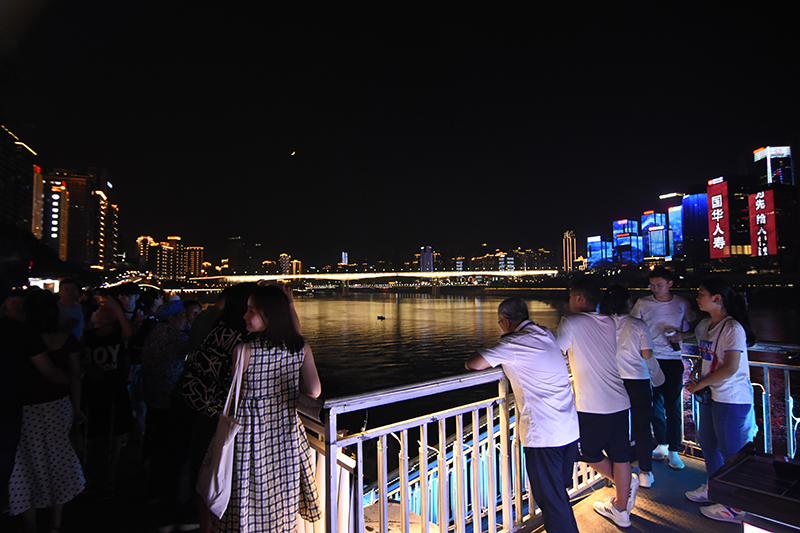
People gathering at Hong Ya Dong excited for the light show
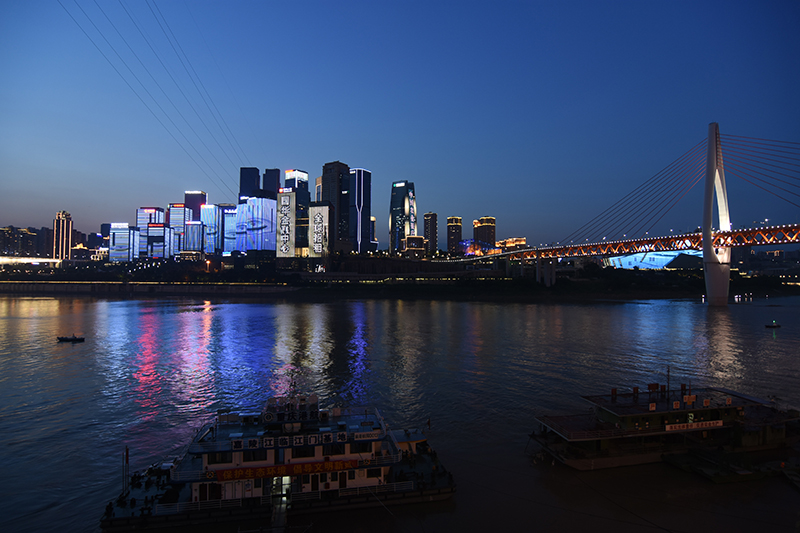
Media Facades that are linked up for the light show
Activity deep into the night
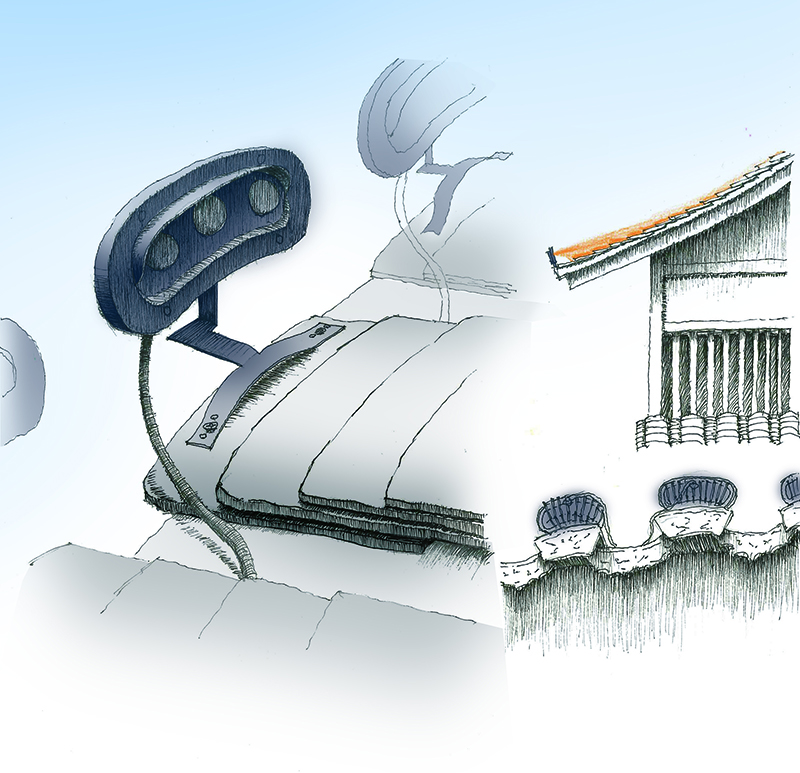
Sketches of the lighting equipment used for the terracotta roof tiles
As the clock ticks past 11 pm, the light shows and buildings that were lit up slowly fade while the number of people gathering near the riverbanks also disperse to start gathering indoors. Perhaps it is because it was Friday, the indoor facilities were filled with people: some families coming to eat hot pot past 0 am, others laying out street stalls to sell fruit, giving me a glimpse of the long active hours of life in Chongqing.
After investigating the tourist spots, we headed to the rooftop observatory of the WFC, the tallest building in Chongqing. You could see that, at the point of the island, there was a dark patch as construction is happening on a set of 6 buildings connected by walkways that stand there. It sort of looks like the sail of a boat, and will definitely become one of the buildings to represent Chongqing when it is finished. The nightscape mainly consisted of crowns, riverbanks, bridge support beams, and roofs, giving the impression that the lighting techniques used here are all emphasizing the outlines. After that, we explored the central area of Jie Fang Bei Square. The area was filled with people waiting for friends to meet up to head into the nightlife. The brightness of the center of the plaza was around 140lx, with the light from the surrounding buildings and advertisements adding to the measurement, but ultimately there was enough light in the area.
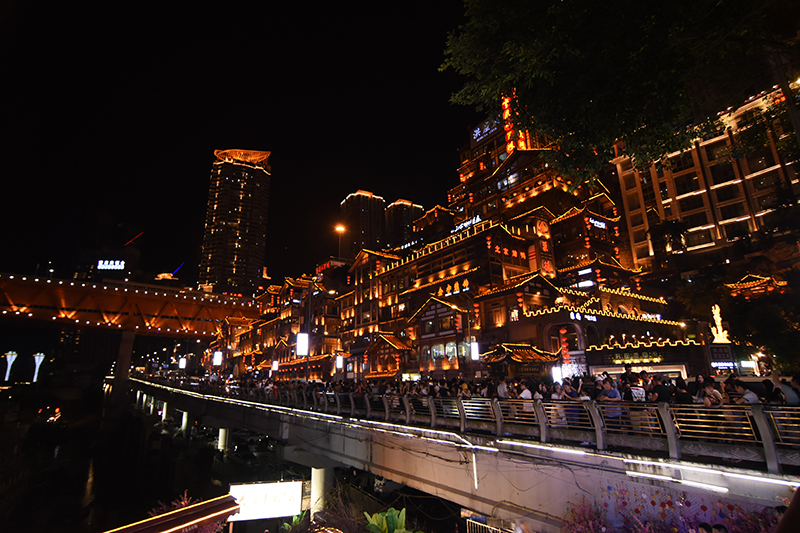
Tourist location lit up with warm lights

Street stalls open deep into the night
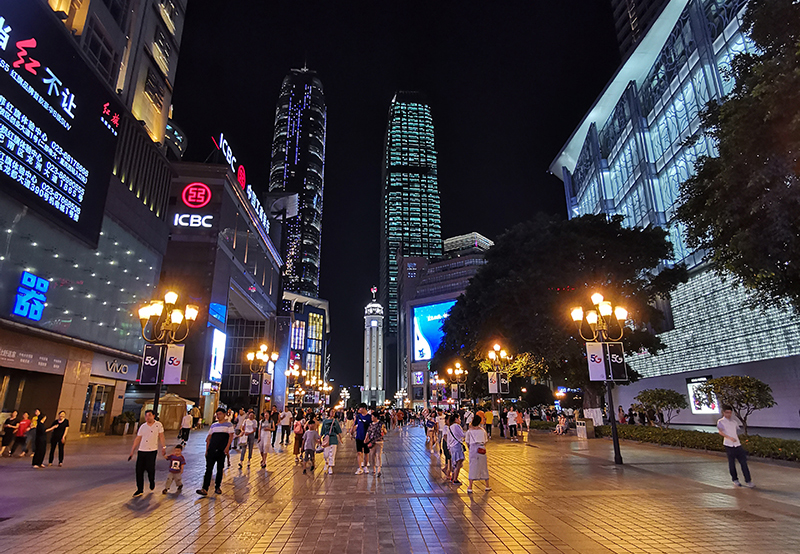
The Jie Fang Bei Area
Conclusion
For the people in Chongqing, I could imagine that lighting was relatively interwoven into their daily life. Even if it was slightly dark during the day, people relied on the warm sunlight. Others ate hot pot after watching the light show at night and bought fruits at the carefully lit street stalls while taking a walk. Because it is a place surrounded by rivers, the view of the sky is vast and there are many places you enjoy the large expanse of the landscape around. Especially with the level differences in the buildings, the same city has new expressions to show depending on where you are looking from. (Masahiro Iwata)
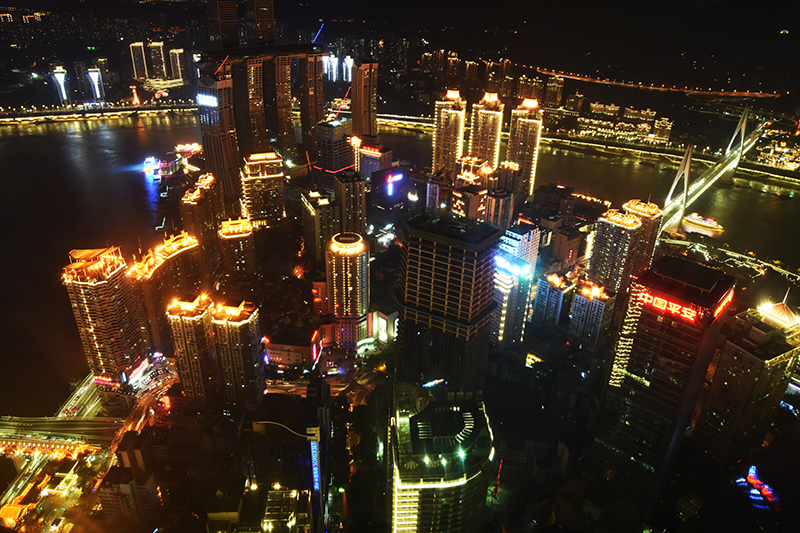
The nightscape overlooking the city from the WFC
Chong Qing Lighting Survey
重庆史光: Re-Celebrating History of Light
2019.07.04 – 2019.07.05 Clement Lee + Iwata Masahiro
Located in upstream of Yang Tze Basin, Chong Qing serves as one of the manufacturing, transportation, and commercial hub of China. Caught within rapid infrastructure changes, this survey seeks to uncover the methods for Architectural and Lighting preservation efforts to reflect the ancient Clement Lee + Iwata Masahiro traditions from the dynasties.
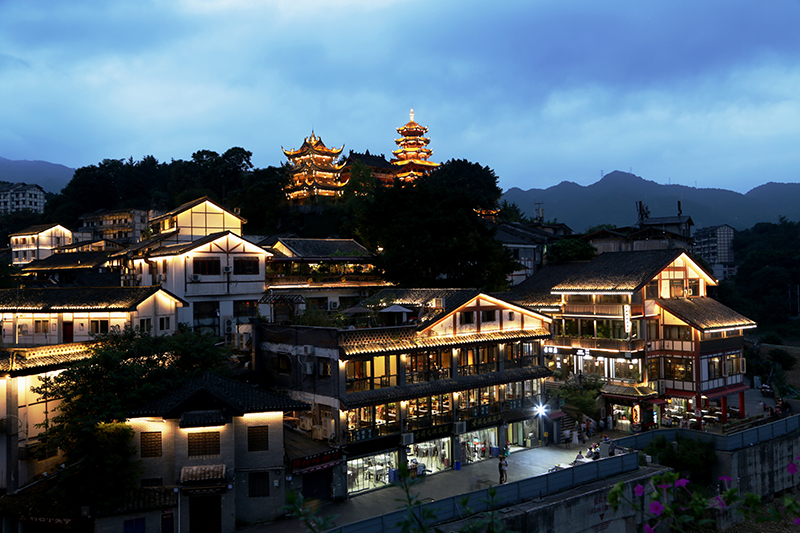
Ci Qi Kou Old Town highlighted with linear architecture facade lighting contrasting the light blue canvas sky of the evening
Old town of Ci Qi Kou (磁器口): Cultural Hub of Chong Qing
Chongqing is a technologically advanced city situated in the mountains of southwest China. With a rich history of being a major economic hub, Chong Qing was propelled to earn a place in the top 13 megalopolises of China. With the theme of understanding and exploring the cultural traditions of Chong Qing, we set out to discover its customs and efforts to preserve the rich traditions which create the unique character that separates this Sze Chuan-influenced province from the other major cities of China.
We began at the heart of the city: the old district of Ci Qi Kou. This old town is currently filled with shops sell goods and traditional food of the old Chongqing. A modernized trading hub that reflects the bustling old port to trade porcelain along the Yangtze River. It was a commercial hub for pioneers back in the Ming and Qing Dynasty(1368 -1911). Teahouses and traditional
theatres dominate the streets alongside the spicy yet tantalizing smell of Mala-hotpot, spices, and barbequed meat during the day.
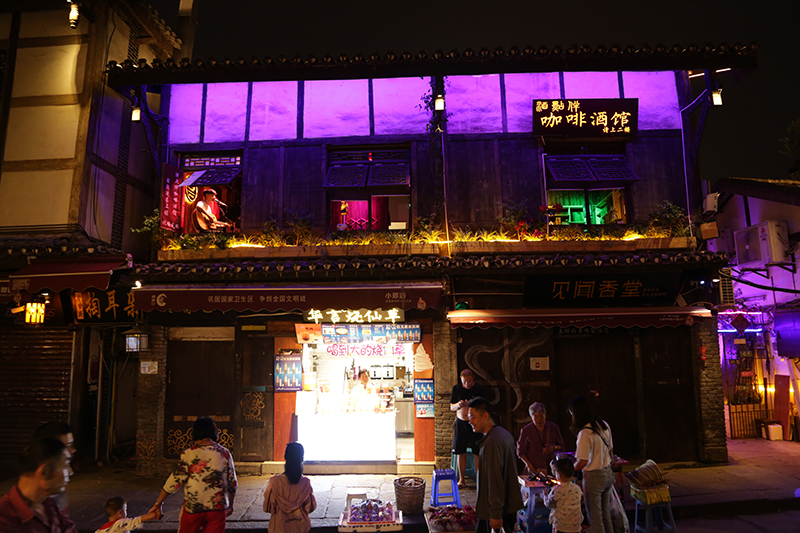
Traditional Tea Houses in the Day transforms into evening Bars
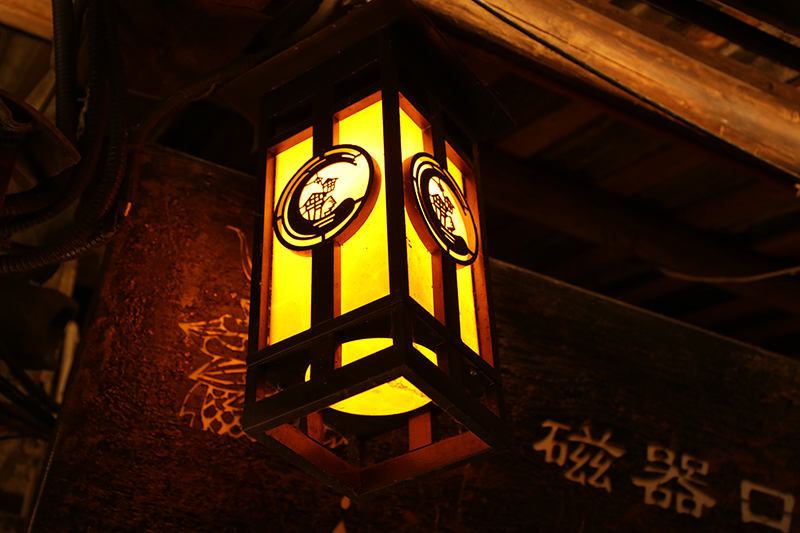
Close up Custom “fire” Lantern bearing the Logo of Ci Qi Kou
We headed into the oldest theatre to understand the rich history of Chinese cultural arts and the formula of balancing the two forms of expressions: Preservation vs modernization.
The theatre’s interior and atmosphere hold similarity to the old teahouses of ancient China where round tables are arranged alternately between rows giving unobstructed views to the stage. Stage lightings are well hidden behind the old architecture structures allowing a glare-free visual experience. We were both thrilled at the thoughtfulness behind this lighting arrangement
and comfortably lit tables around the stage.
Colour-coordinated handcrafted lanterns along every walkway indicate the trails that provide wayfinding around the theatre’s premises.
However, the atmosphere takes a dramatic twist once nightfall, the traditional teahouses transform into modern bars.
Lanterns light up the street like ancient traditional street lanterns used in the Han dynasty. The street-level still maintains the same concept of the past where these lanterns were the only public lighting for the street where bars are absent, providing an authentic historic experience.
The traditional lanterns complement the street’s modern character alongside the bars’ neon lights, creating a seemingly poetic sense of coexistence with its roots. Linear lights highlight the facade of the shophouses and showcase the history and architectural elements that withstood years of re-purposing.
We left the district after understanding its cohesive planning to retain traditions yet rebranding the spirit of merchant-trading in these modern changing times.
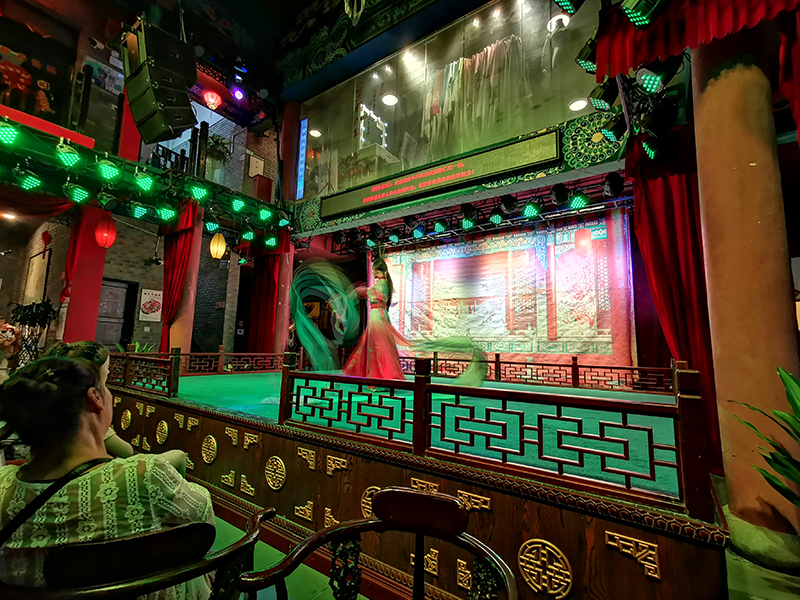
Cultural traditions complimented with modern stage lighting
New District of Tan Zhi Shi (弹子石):Residential Oasis of Chong Qing
After understanding China’s efforts to preserve such lighting methods in the strive for progress, a trip to the new residential district was done to survey and document changes that were applied.
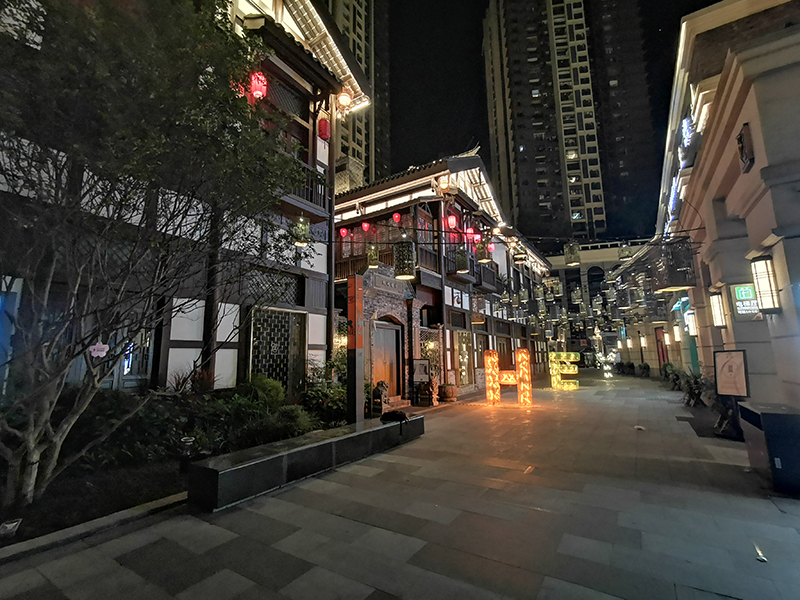
Tan Zhi Shi District highlighted with linear architecture light contrasting the mild facade lighting of the residential blocks
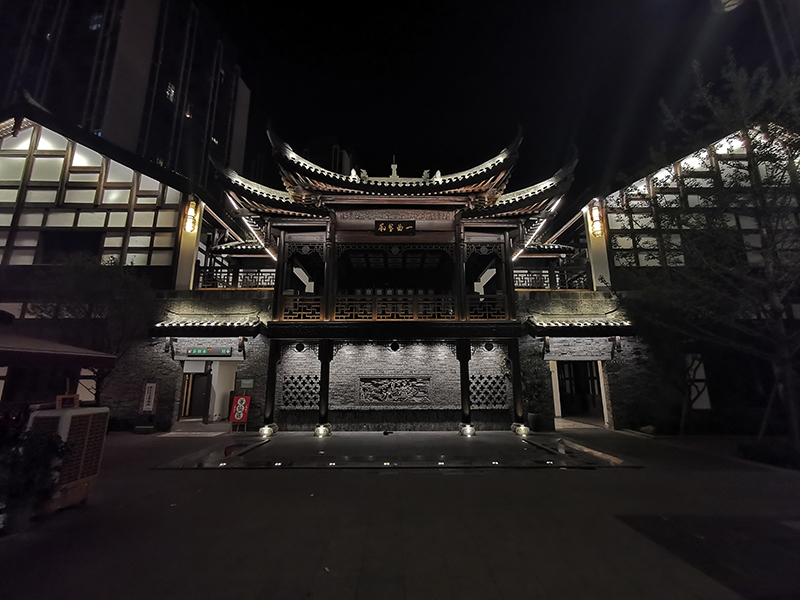
Linear architectural lights outlines the details of chinese construction
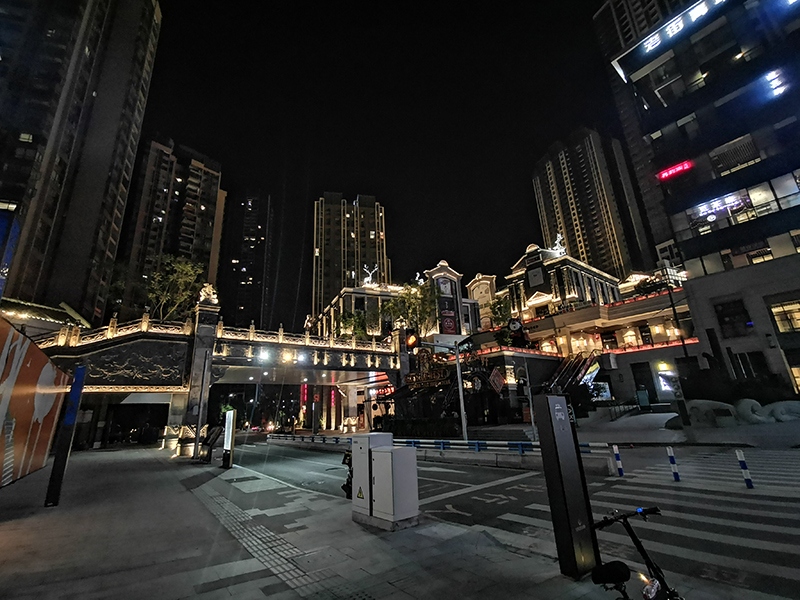
Hanging Lanterns with wall scones fills every shopping street
The downtown district of Tan Zhi Shi is a new mixed self-sufficient entertainment hub, complete with daily facilities resembling a miniature city. This district uses the same architectural typology of the old towns with the same lighting methods to create a strong
Comparison of Uptown & Downtown.( 弹子石 and 磁器口)
I feel that both areas are built on similar concepts and foundation to preserve and showcase the history of Chinese architectural elements and materials. The tourist-packed Ci Qi Kou co- xists with its historical past using “Fire Lanterns” that line the street level facade and roof highlights upon nightfall.
Tan Zhi Shi’s consumer profile targets the other end of the spectrum; locals. Lighting in this Special Festive design lights illuminating road with landmarks Street Stores using spiral E27 bulbs with red lamp shades Downtown old residential district of the locals Glaring ambient lighting for the icon of this district – The Reindeer contrast. Tan Zhi Shi’s shopping directory is dominated by trendy retail outlets and budding cafes and its main audience is of the younger generation. Located on the opposite shore of the Jiefangbei, it serves as one of the many
oasis that surrounds the Jiefangbei district, distinctly filled with locals. Lighting fixtures found within the street levels are more decorative; such as sculpture and catenary lighting to
cater to younger visitors that frequent this area.
However, on the roof facade level, architectural linear lights are being used to outline the Chinese architectural elements. The further survey also reveals the upmarket character of this district from the finishes and wall textures found on the facade and street level. Catenary lighting that was hanging zig-zag across the width of the streets is custom-fabricated with district-related icons and motifs that complement the rare earth stones used on the facade. The culture and vibe in this district appear to be more casual compared to the main tourist area as the main plaza is filled with the younger generation, practicing dance choreography throughout the evening. Linear facade lights were eventually dimmed down and other lights are switched off past midnight, unlike the tourist-heavy districts.
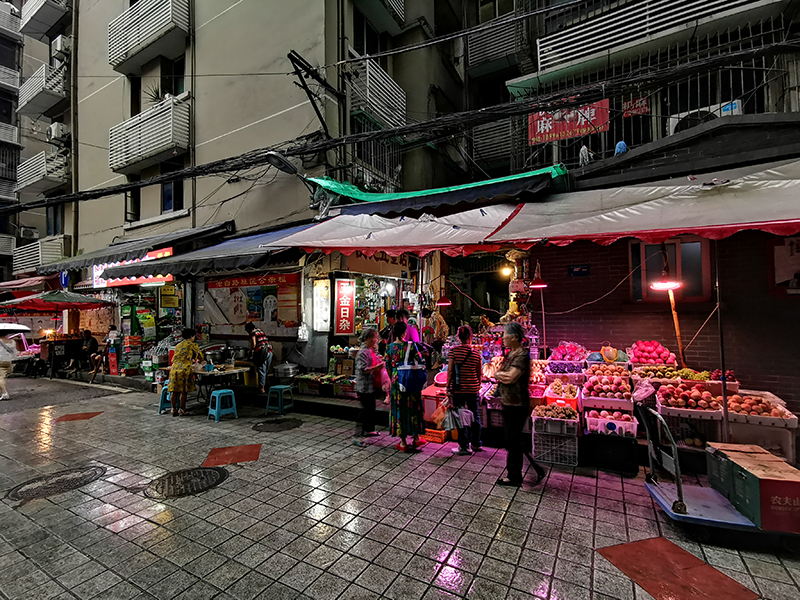
Street Stores using spiral E27 bulbs with red lamp shades
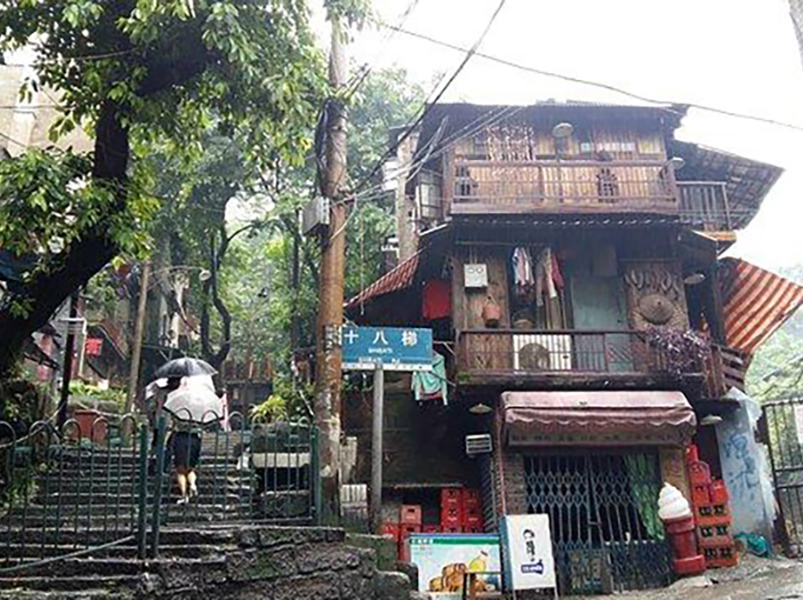
Downtown old residential district of the locals
City Night Walk Vol.064:Skybus Tour
2019.07.26 Anri Sato+ Mutsuro Honma
For our 64th Stroll about town, we explored the Tokyo Nightscape using a 2 story open roof bus: Skybus. It was a great drive around town, using Skybus’ Odaiba Nightscape course.
While we started the event with some concerns about bad weather, but luckily we were able to enjoy a beautiful summer night drive.
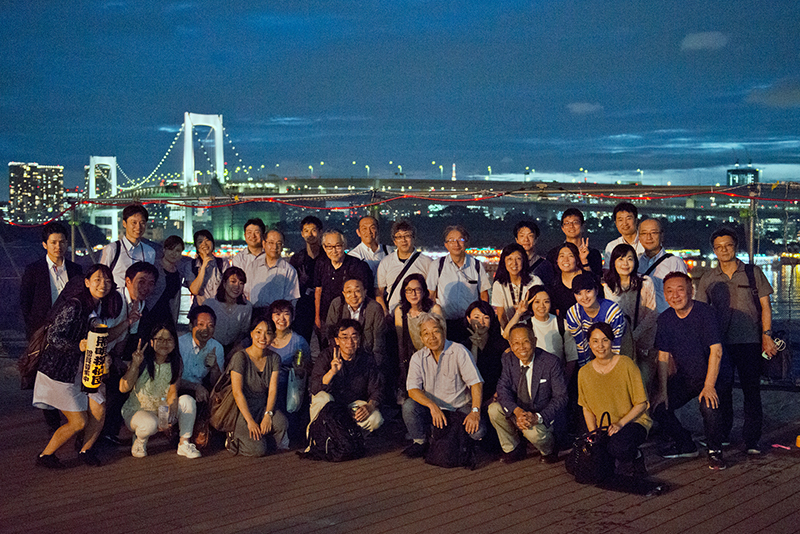
A group photo at Odaiba with the rainbow bridge behind us
Skybus The Significance of the Skybus tour

We started before it got dark
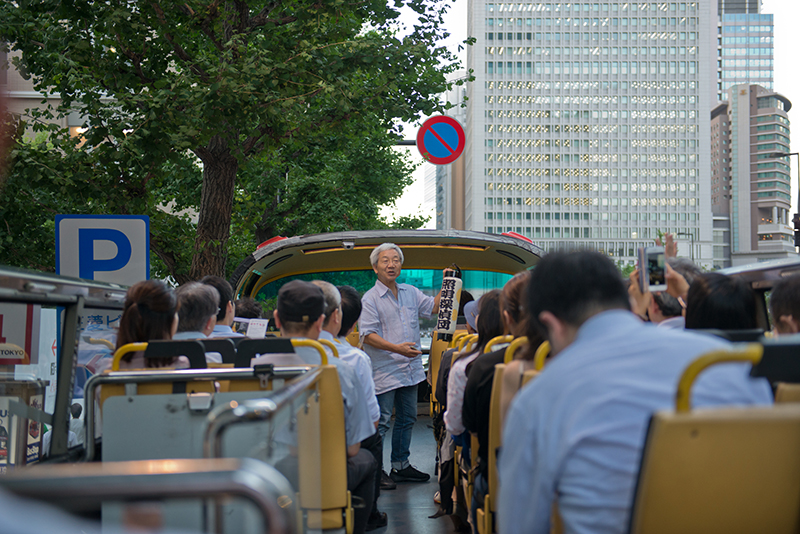
Chief Mende-san explaining the point of the bus tour
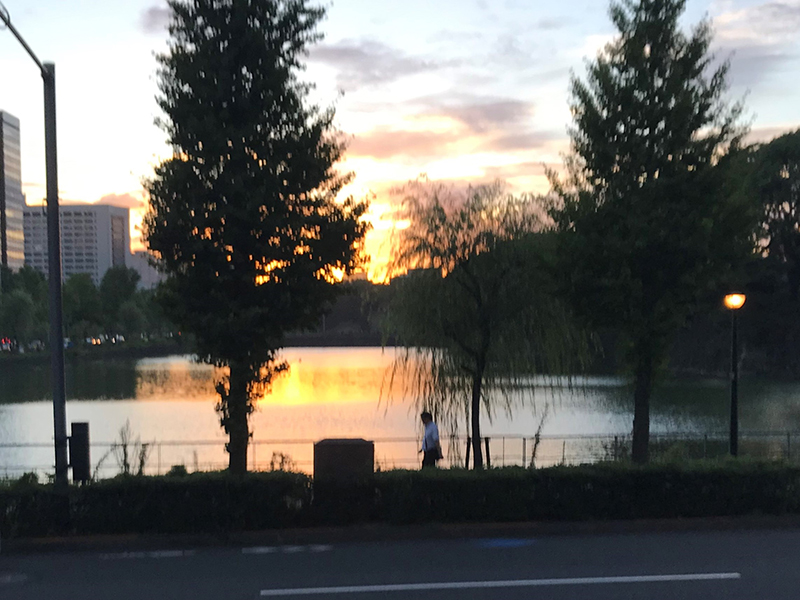
The sunset setting upon the emperor’s residence
Under the theme of ‘Rediscovering the nightscape of Tokyo on the Skybus!’, our members all explored the nightscape of Tokyo from a height of 3.8m off the ground.
Our route was Tokyo Station → Oukyo (Emperor’s residence) → Tokyo Tower → Shuto Highway → Rainbow Bridge → Odaiba → Shuto Highway → Rainbow Bridge → Tsukiji Market → Ginza → Hibiya → Marunouchi → Tokyo Station
The lighting detectives also held the same event in 2013, but as the 2020 Olympics/Paralympics are under a year away, there are heavy development projects occurring all around Tokyo and therefore would perhaps change the nightscape of the city. We were curious to explore how the nightscape of Tokyo has changed especially after the Tsukiji market has moved completely to the Toyosu Market.
The highlight of this trip is the nightscape of Tokyo you see when you are driving on the Shuto Highway.
We enjoyed the combination of the large expansive sky, the nightscape, and the soothing wind that we could not normally enjoy on our own. The speed at which we travel is also completely different in comparison to our normal strolls and the view of the city at that speed and height gave us a completely different perspective as before.
At Odaiba, we took a 60-minute break and took a walk at Odaiba Marine Park. This area is a quiet beach right now but will have temporary constructions in order to accommodate some Olympic sporting events. Further, the athletes housing will be located at Chuoku Harumi. It seems after the games, it would be rebuilt into some high-rise apartments. On the day of exploration, it was still before the construction, so it was filled with imagining how the view would be after the buildings were built.
(Anri Sato)
Reflection on the exploration
The perks of the Skybus tour is that it allows us to experience the city of Tokyo at a different speed and perspective. It seems that even if you thought that you knew Tokyo like the back of your hand, there were things that would surprise you if you were to change your perspective.
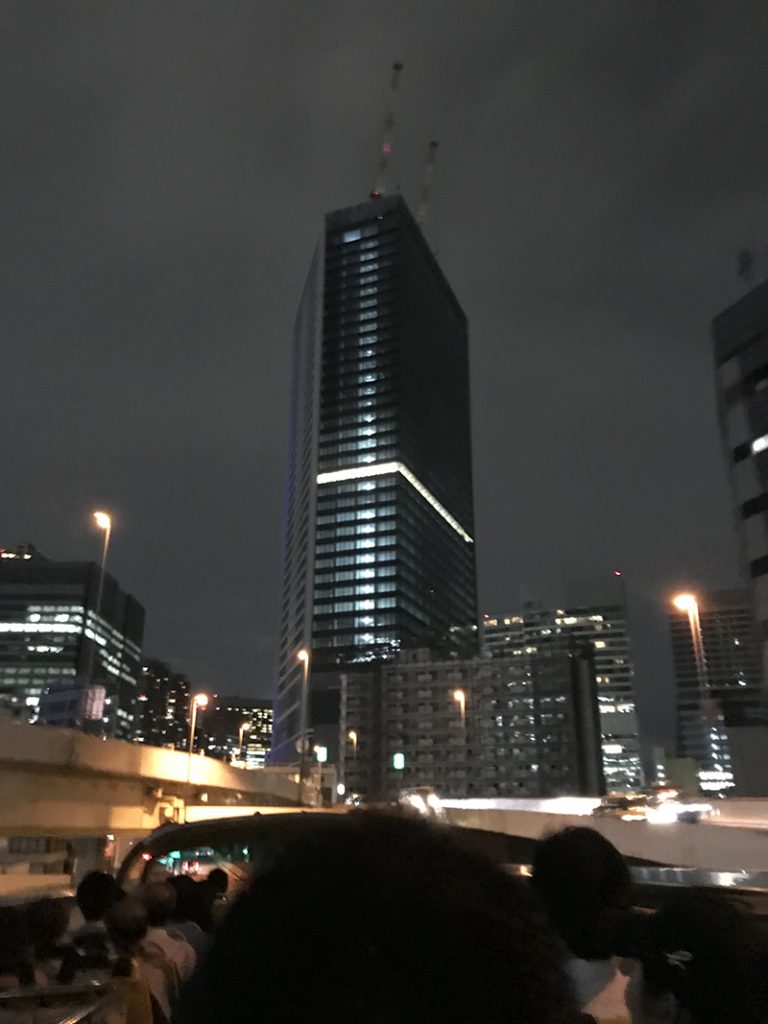
Without any trouble from the Typhoon or rain that we thought could ruin our plans, the bus started driving under the blue sky. It was still bright out when Leader Mende-san started his greetings, but we could feel the sun hitting our skin slowly change angles, slowly bringing us into the night. The sun that was setting on the emperor’s residence was beautiful. There was also a building that had their window frame structures protruding from the building, creating a nice shadow once it was hit by the sunset, creating a great balance of light and shadow.
As we approached twilight, the bus approached Tokyo Tower. We were able to look at Tokyo Tower from a very close distance, but we were able to see different sides and expressions of it as we drove around. As the sky turned a deep blue on the east and remained red on the west, the different skies gave the Tokyo Tower completely different looks and left different impressions. Enjoying these different views on the same trip was something we could only achieve with the speed that we had on the bus.
The sun had set completely when we arrived at Odaiba. The boats parked on the river reflected beautifully in the water. The airplane warning lights blinking was also beautiful. These lights that blink still often use incandescent lamps, resulting in a soft fade for its blinking. It was sort of sad to think about the change to LEDs in this case, as we would lose this special moment to the clean blinking of the LEDs. But looking it up just now, even if they replaced the incandescent bulbs with LEDs, they would do so with LEDs with the capability to replicate the slow fade of the incandescent bulbs. Perhaps they also are considering the upkeep of the nightscape while they make these decisions! If that is true, that would be amazing.
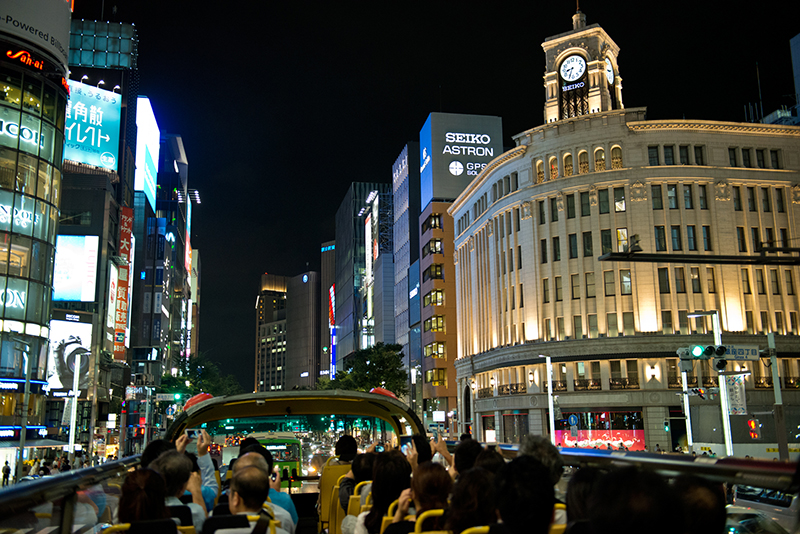
The Skybus driving through the charming Ginza nightscape
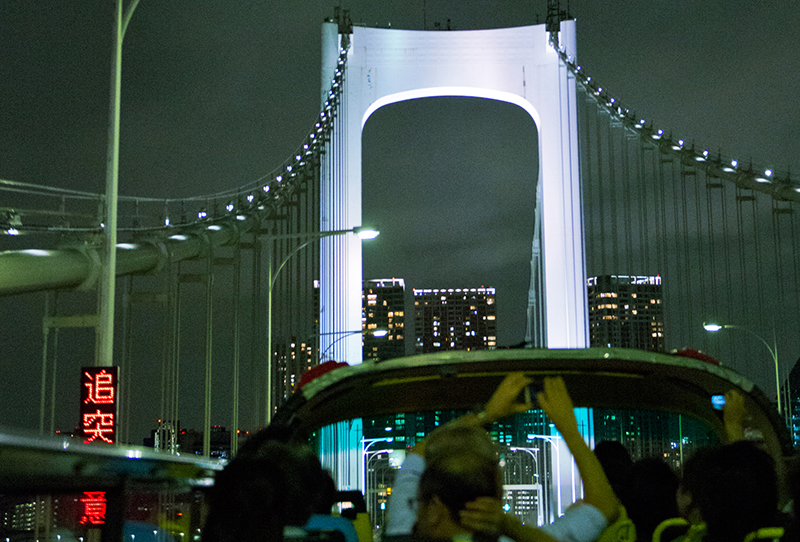
Looking up at the rainbow bridge in an open roof car
As we left Odaiba, the bus took us on the Shuto Highway once again. The night has befallen and we are now looking at a scene that better expresses the Tokyo nightscape than when we were on our way to Odaiba. As we are moving much faster than usual, the flourishing nightscape of Tokyo looks somewhat different. Suddenly, there was a building, with only one floor under construction that caught my eye. The black block of a building, with the bright Tokyo nightscape as a backdrop, has a single line of light. This was beautiful and left a lasting impression. This floor was probably the floor used by the architecture company as their office. This is probably the last bit of work till the completion of the building. It seems slightly out of place to say this view is beautiful as the workers are probably working and stressed, but I believe that the temporary nature of this view is what makes it beautiful and precious. With thoughts for those working in the building and also enjoying the view, it mesmerized me for a while.
Looking at the weather forecast, it was a miracle that it hadn’t rained by the time the bus pulled up to Tokyo Station, taking us back to where we started.
This was a trip that turned out better than expected, with many locations to take a look at and even more to discover.
We could also see the renewed Tosoyu Market and the old market that is about to be demolished. Further, Tokyo is changing in preparation for the Olympics. However, even as the city changes continuously, I felt that the people here continue to remain the same.
This was a trip that left me feeling as if changing my perspective allowed me to look at not just the changing city and nightscape but also others hard work around the city. (Mutsuro Honma)
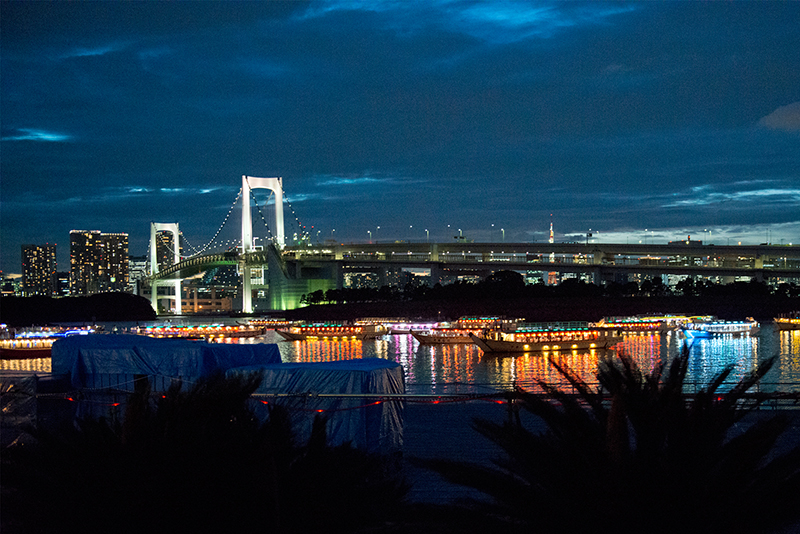
Shomei Tanteidan Tsu-shin
Congratulations on 100 volumes!
Lighting Detectives Chief Kaoru Mende
We have continued our activities as the Lighting Detectives for 29 years with the words ‘Continuation is Strength’ in our minds. Well, it feels long, but at the same time sort of short… To be honest, I have felt a crisis a few times during these years, complaining to our staff members, saying ‘perhaps we should change it up and do something new or else we would just become something that is done out of ritual and not be as meaningful.’ However, we were able to get to this milestone with everything intact because the will of the Lighting Detectives was unchanging and because we were able to have fun with everyone. Thank you for your support. It means we were about to release 100 volumes of newsletters in these past 29 years. This is also an impressive milestone. The newsletters of before were quite different from the ones that are written these days. The people who wrote them were the same and there was no checking process for the content, so people probably just wrote what they wanted. The newsletters these days are closer to reports by journalists and are more exciting to read. Though the texts do get longer and photos are getting too small.
What we find most important in this group is the difference of opinions. Most groups appreciate the homogeneity of the group, where everyone is of the same mind and opinion, but the Lighting Detectives appreciate the intermingling and the discussions that result from the different opinions and perspectives. Our opinions on lighting differ based on our age, gender, area and time we live in, our culture, nationality, and beliefs. There is no answer to what the correct opinion is. The important and interesting part is how our differences in opinion occur.
That is why, in our ‘Shomei Tanteidan Tsushin’ it isn’t enough to report just facts such as‘what we saw where’, ‘this was the brightness’. It is important to express your own unique thoughts and why you think that way.
I look forward to exchanging even more unfiltered opinions and values through this newsletter.





